Communication Process during Brisbane Floods 2011
VerifiedAdded on 2023/06/07
|7
|1770
|375
AI Summary
The report evaluates the communication process taken place between Brisbane Council and its residents as well as businesses during the situation of crisis by shedding light on significant gaps and issues which affected the communication. It also discusses the stakeholders accountability in Brisbane Disaster Communication and provides recommendations.
Contribute Materials
Your contribution can guide someone’s learning journey. Share your
documents today.
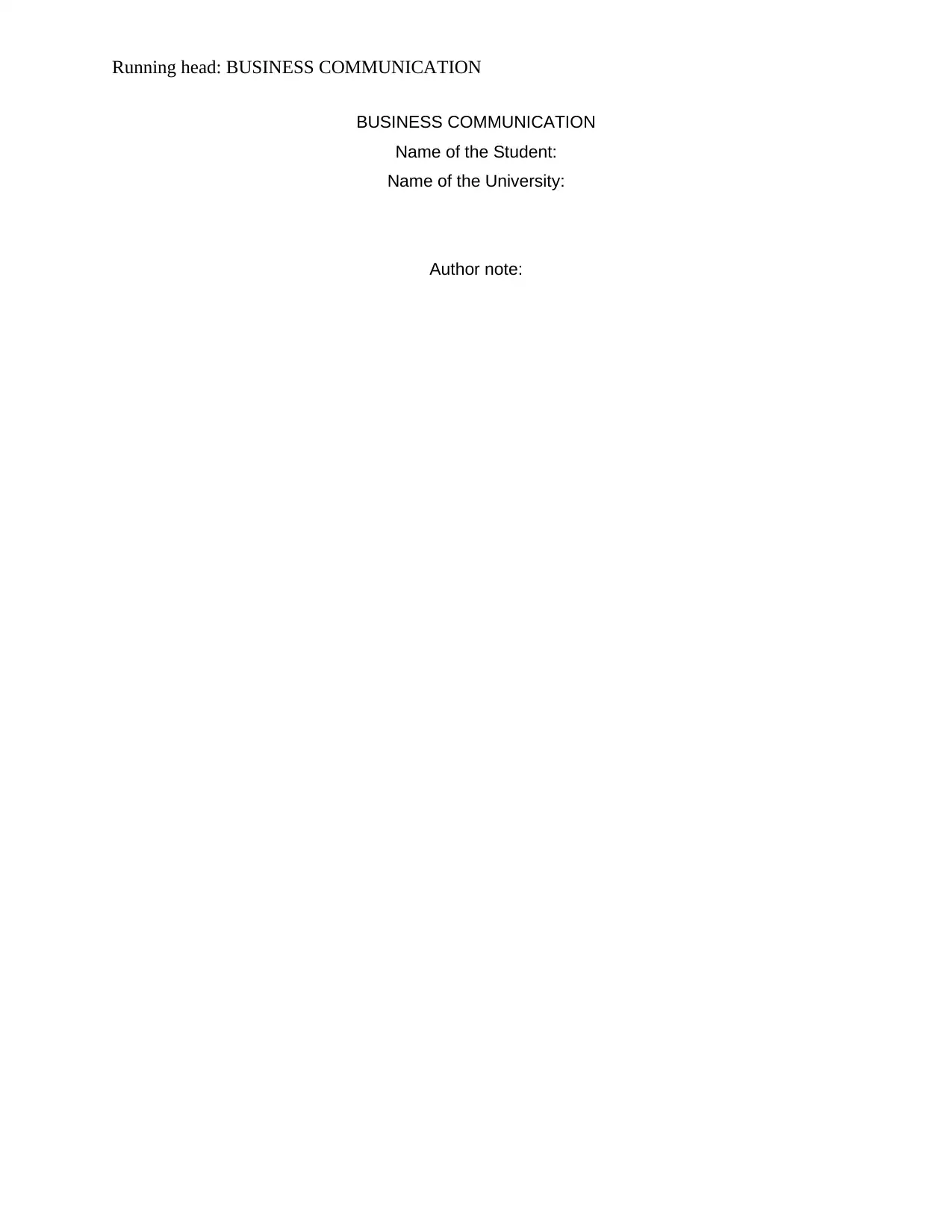
Running head: BUSINESS COMMUNICATION
BUSINESS COMMUNICATION
Name of the Student:
Name of the University:
Author note:
BUSINESS COMMUNICATION
Name of the Student:
Name of the University:
Author note:
Secure Best Marks with AI Grader
Need help grading? Try our AI Grader for instant feedback on your assignments.
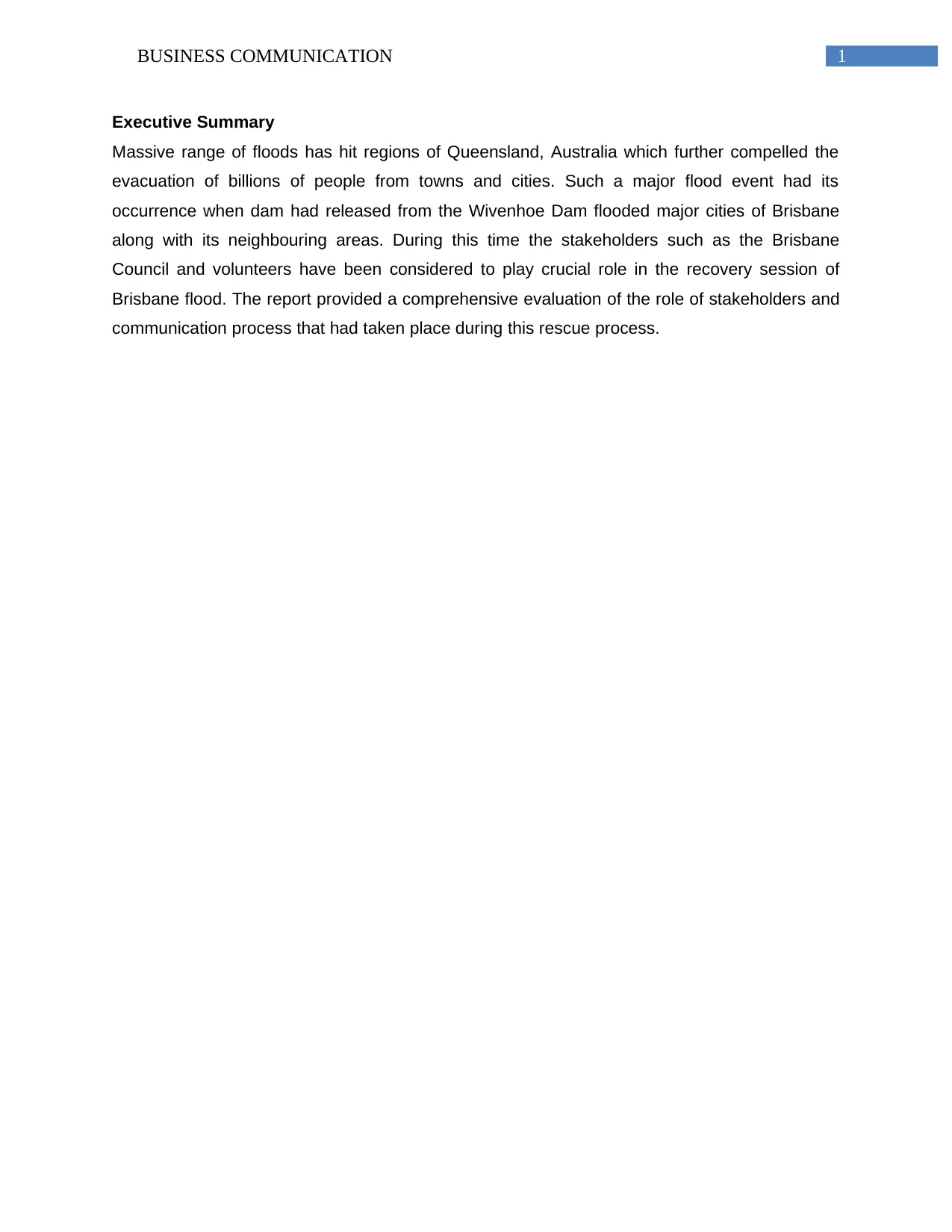
1BUSINESS COMMUNICATION
Executive Summary
Massive range of floods has hit regions of Queensland, Australia which further compelled the
evacuation of billions of people from towns and cities. Such a major flood event had its
occurrence when dam had released from the Wivenhoe Dam flooded major cities of Brisbane
along with its neighbouring areas. During this time the stakeholders such as the Brisbane
Council and volunteers have been considered to play crucial role in the recovery session of
Brisbane flood. The report provided a comprehensive evaluation of the role of stakeholders and
communication process that had taken place during this rescue process.
Executive Summary
Massive range of floods has hit regions of Queensland, Australia which further compelled the
evacuation of billions of people from towns and cities. Such a major flood event had its
occurrence when dam had released from the Wivenhoe Dam flooded major cities of Brisbane
along with its neighbouring areas. During this time the stakeholders such as the Brisbane
Council and volunteers have been considered to play crucial role in the recovery session of
Brisbane flood. The report provided a comprehensive evaluation of the role of stakeholders and
communication process that had taken place during this rescue process.
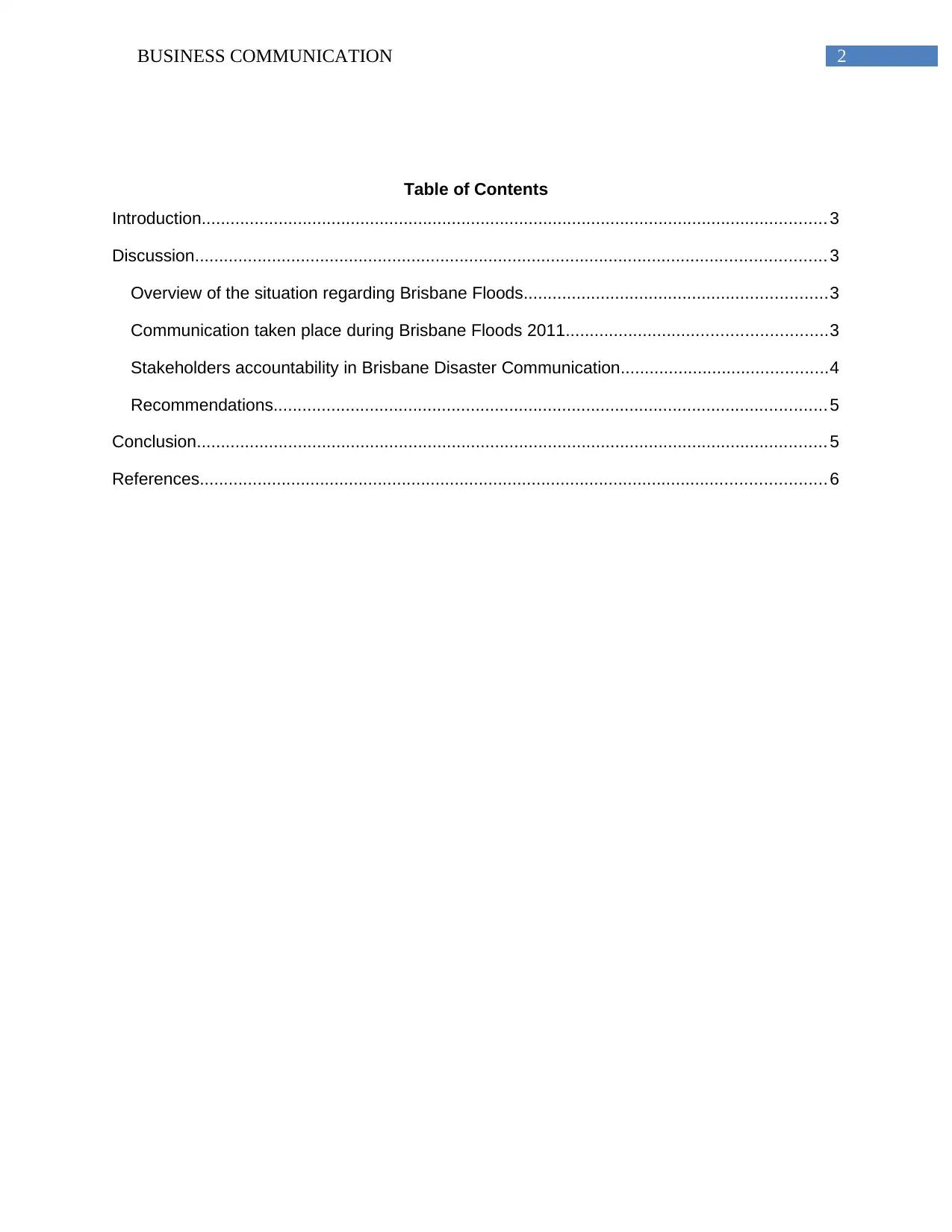
2BUSINESS COMMUNICATION
Table of Contents
Introduction.................................................................................................................................. 3
Discussion................................................................................................................................... 3
Overview of the situation regarding Brisbane Floods...............................................................3
Communication taken place during Brisbane Floods 2011......................................................3
Stakeholders accountability in Brisbane Disaster Communication...........................................4
Recommendations................................................................................................................... 5
Conclusion................................................................................................................................... 5
References.................................................................................................................................. 6
Table of Contents
Introduction.................................................................................................................................. 3
Discussion................................................................................................................................... 3
Overview of the situation regarding Brisbane Floods...............................................................3
Communication taken place during Brisbane Floods 2011......................................................3
Stakeholders accountability in Brisbane Disaster Communication...........................................4
Recommendations................................................................................................................... 5
Conclusion................................................................................................................................... 5
References.................................................................................................................................. 6
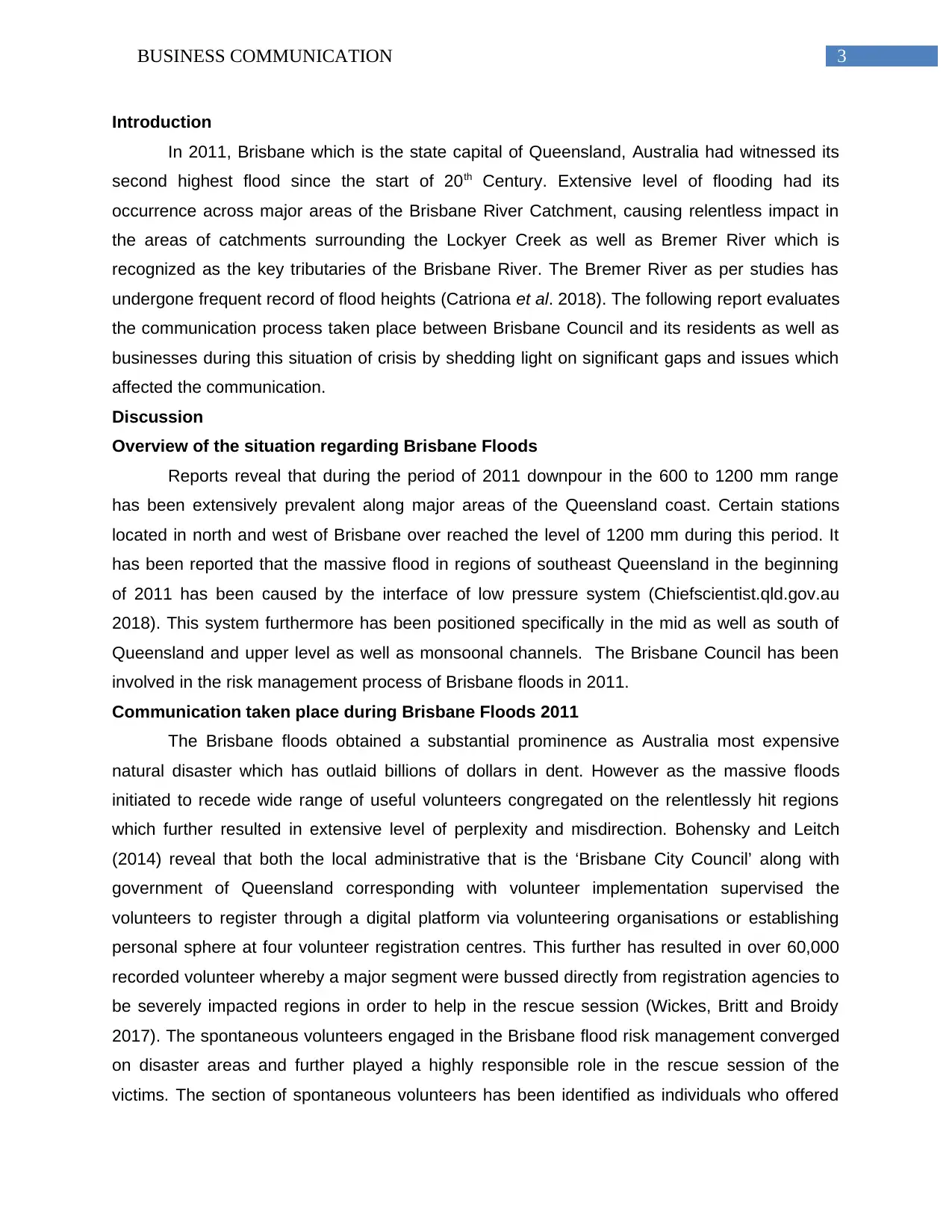
3BUSINESS COMMUNICATION
Introduction
In 2011, Brisbane which is the state capital of Queensland, Australia had witnessed its
second highest flood since the start of 20th Century. Extensive level of flooding had its
occurrence across major areas of the Brisbane River Catchment, causing relentless impact in
the areas of catchments surrounding the Lockyer Creek as well as Bremer River which is
recognized as the key tributaries of the Brisbane River. The Bremer River as per studies has
undergone frequent record of flood heights (Catriona et al. 2018). The following report evaluates
the communication process taken place between Brisbane Council and its residents as well as
businesses during this situation of crisis by shedding light on significant gaps and issues which
affected the communication.
Discussion
Overview of the situation regarding Brisbane Floods
Reports reveal that during the period of 2011 downpour in the 600 to 1200 mm range
has been extensively prevalent along major areas of the Queensland coast. Certain stations
located in north and west of Brisbane over reached the level of 1200 mm during this period. It
has been reported that the massive flood in regions of southeast Queensland in the beginning
of 2011 has been caused by the interface of low pressure system (Chiefscientist.qld.gov.au
2018). This system furthermore has been positioned specifically in the mid as well as south of
Queensland and upper level as well as monsoonal channels. The Brisbane Council has been
involved in the risk management process of Brisbane floods in 2011.
Communication taken place during Brisbane Floods 2011
The Brisbane floods obtained a substantial prominence as Australia most expensive
natural disaster which has outlaid billions of dollars in dent. However as the massive floods
initiated to recede wide range of useful volunteers congregated on the relentlessly hit regions
which further resulted in extensive level of perplexity and misdirection. Bohensky and Leitch
(2014) reveal that both the local administrative that is the ‘Brisbane City Council’ along with
government of Queensland corresponding with volunteer implementation supervised the
volunteers to register through a digital platform via volunteering organisations or establishing
personal sphere at four volunteer registration centres. This further has resulted in over 60,000
recorded volunteer whereby a major segment were bussed directly from registration agencies to
be severely impacted regions in order to help in the rescue session (Wickes, Britt and Broidy
2017). The spontaneous volunteers engaged in the Brisbane flood risk management converged
on disaster areas and further played a highly responsible role in the rescue session of the
victims. The section of spontaneous volunteers has been identified as individuals who offered
Introduction
In 2011, Brisbane which is the state capital of Queensland, Australia had witnessed its
second highest flood since the start of 20th Century. Extensive level of flooding had its
occurrence across major areas of the Brisbane River Catchment, causing relentless impact in
the areas of catchments surrounding the Lockyer Creek as well as Bremer River which is
recognized as the key tributaries of the Brisbane River. The Bremer River as per studies has
undergone frequent record of flood heights (Catriona et al. 2018). The following report evaluates
the communication process taken place between Brisbane Council and its residents as well as
businesses during this situation of crisis by shedding light on significant gaps and issues which
affected the communication.
Discussion
Overview of the situation regarding Brisbane Floods
Reports reveal that during the period of 2011 downpour in the 600 to 1200 mm range
has been extensively prevalent along major areas of the Queensland coast. Certain stations
located in north and west of Brisbane over reached the level of 1200 mm during this period. It
has been reported that the massive flood in regions of southeast Queensland in the beginning
of 2011 has been caused by the interface of low pressure system (Chiefscientist.qld.gov.au
2018). This system furthermore has been positioned specifically in the mid as well as south of
Queensland and upper level as well as monsoonal channels. The Brisbane Council has been
involved in the risk management process of Brisbane floods in 2011.
Communication taken place during Brisbane Floods 2011
The Brisbane floods obtained a substantial prominence as Australia most expensive
natural disaster which has outlaid billions of dollars in dent. However as the massive floods
initiated to recede wide range of useful volunteers congregated on the relentlessly hit regions
which further resulted in extensive level of perplexity and misdirection. Bohensky and Leitch
(2014) reveal that both the local administrative that is the ‘Brisbane City Council’ along with
government of Queensland corresponding with volunteer implementation supervised the
volunteers to register through a digital platform via volunteering organisations or establishing
personal sphere at four volunteer registration centres. This further has resulted in over 60,000
recorded volunteer whereby a major segment were bussed directly from registration agencies to
be severely impacted regions in order to help in the rescue session (Wickes, Britt and Broidy
2017). The spontaneous volunteers engaged in the Brisbane flood risk management converged
on disaster areas and further played a highly responsible role in the rescue session of the
victims. The section of spontaneous volunteers has been identified as individuals who offered
Secure Best Marks with AI Grader
Need help grading? Try our AI Grader for instant feedback on your assignments.
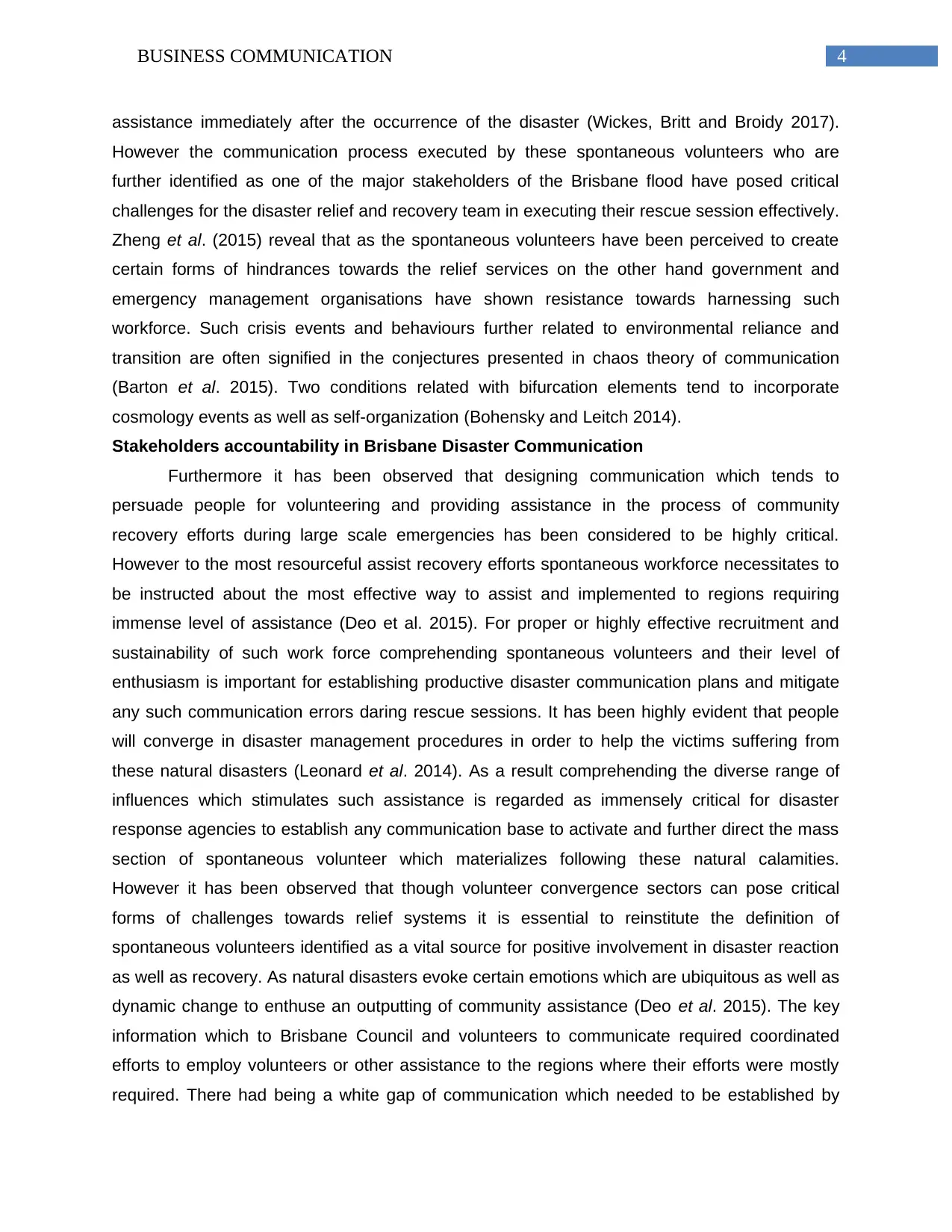
4BUSINESS COMMUNICATION
assistance immediately after the occurrence of the disaster (Wickes, Britt and Broidy 2017).
However the communication process executed by these spontaneous volunteers who are
further identified as one of the major stakeholders of the Brisbane flood have posed critical
challenges for the disaster relief and recovery team in executing their rescue session effectively.
Zheng et al. (2015) reveal that as the spontaneous volunteers have been perceived to create
certain forms of hindrances towards the relief services on the other hand government and
emergency management organisations have shown resistance towards harnessing such
workforce. Such crisis events and behaviours further related to environmental reliance and
transition are often signified in the conjectures presented in chaos theory of communication
(Barton et al. 2015). Two conditions related with bifurcation elements tend to incorporate
cosmology events as well as self-organization (Bohensky and Leitch 2014).
Stakeholders accountability in Brisbane Disaster Communication
Furthermore it has been observed that designing communication which tends to
persuade people for volunteering and providing assistance in the process of community
recovery efforts during large scale emergencies has been considered to be highly critical.
However to the most resourceful assist recovery efforts spontaneous workforce necessitates to
be instructed about the most effective way to assist and implemented to regions requiring
immense level of assistance (Deo et al. 2015). For proper or highly effective recruitment and
sustainability of such work force comprehending spontaneous volunteers and their level of
enthusiasm is important for establishing productive disaster communication plans and mitigate
any such communication errors daring rescue sessions. It has been highly evident that people
will converge in disaster management procedures in order to help the victims suffering from
these natural disasters (Leonard et al. 2014). As a result comprehending the diverse range of
influences which stimulates such assistance is regarded as immensely critical for disaster
response agencies to establish any communication base to activate and further direct the mass
section of spontaneous volunteer which materializes following these natural calamities.
However it has been observed that though volunteer convergence sectors can pose critical
forms of challenges towards relief systems it is essential to reinstitute the definition of
spontaneous volunteers identified as a vital source for positive involvement in disaster reaction
as well as recovery. As natural disasters evoke certain emotions which are ubiquitous as well as
dynamic change to enthuse an outputting of community assistance (Deo et al. 2015). The key
information which to Brisbane Council and volunteers to communicate required coordinated
efforts to employ volunteers or other assistance to the regions where their efforts were mostly
required. There had being a white gap of communication which needed to be established by
assistance immediately after the occurrence of the disaster (Wickes, Britt and Broidy 2017).
However the communication process executed by these spontaneous volunteers who are
further identified as one of the major stakeholders of the Brisbane flood have posed critical
challenges for the disaster relief and recovery team in executing their rescue session effectively.
Zheng et al. (2015) reveal that as the spontaneous volunteers have been perceived to create
certain forms of hindrances towards the relief services on the other hand government and
emergency management organisations have shown resistance towards harnessing such
workforce. Such crisis events and behaviours further related to environmental reliance and
transition are often signified in the conjectures presented in chaos theory of communication
(Barton et al. 2015). Two conditions related with bifurcation elements tend to incorporate
cosmology events as well as self-organization (Bohensky and Leitch 2014).
Stakeholders accountability in Brisbane Disaster Communication
Furthermore it has been observed that designing communication which tends to
persuade people for volunteering and providing assistance in the process of community
recovery efforts during large scale emergencies has been considered to be highly critical.
However to the most resourceful assist recovery efforts spontaneous workforce necessitates to
be instructed about the most effective way to assist and implemented to regions requiring
immense level of assistance (Deo et al. 2015). For proper or highly effective recruitment and
sustainability of such work force comprehending spontaneous volunteers and their level of
enthusiasm is important for establishing productive disaster communication plans and mitigate
any such communication errors daring rescue sessions. It has been highly evident that people
will converge in disaster management procedures in order to help the victims suffering from
these natural disasters (Leonard et al. 2014). As a result comprehending the diverse range of
influences which stimulates such assistance is regarded as immensely critical for disaster
response agencies to establish any communication base to activate and further direct the mass
section of spontaneous volunteer which materializes following these natural calamities.
However it has been observed that though volunteer convergence sectors can pose critical
forms of challenges towards relief systems it is essential to reinstitute the definition of
spontaneous volunteers identified as a vital source for positive involvement in disaster reaction
as well as recovery. As natural disasters evoke certain emotions which are ubiquitous as well as
dynamic change to enthuse an outputting of community assistance (Deo et al. 2015). The key
information which to Brisbane Council and volunteers to communicate required coordinated
efforts to employ volunteers or other assistance to the regions where their efforts were mostly
required. There had being a white gap of communication which needed to be established by
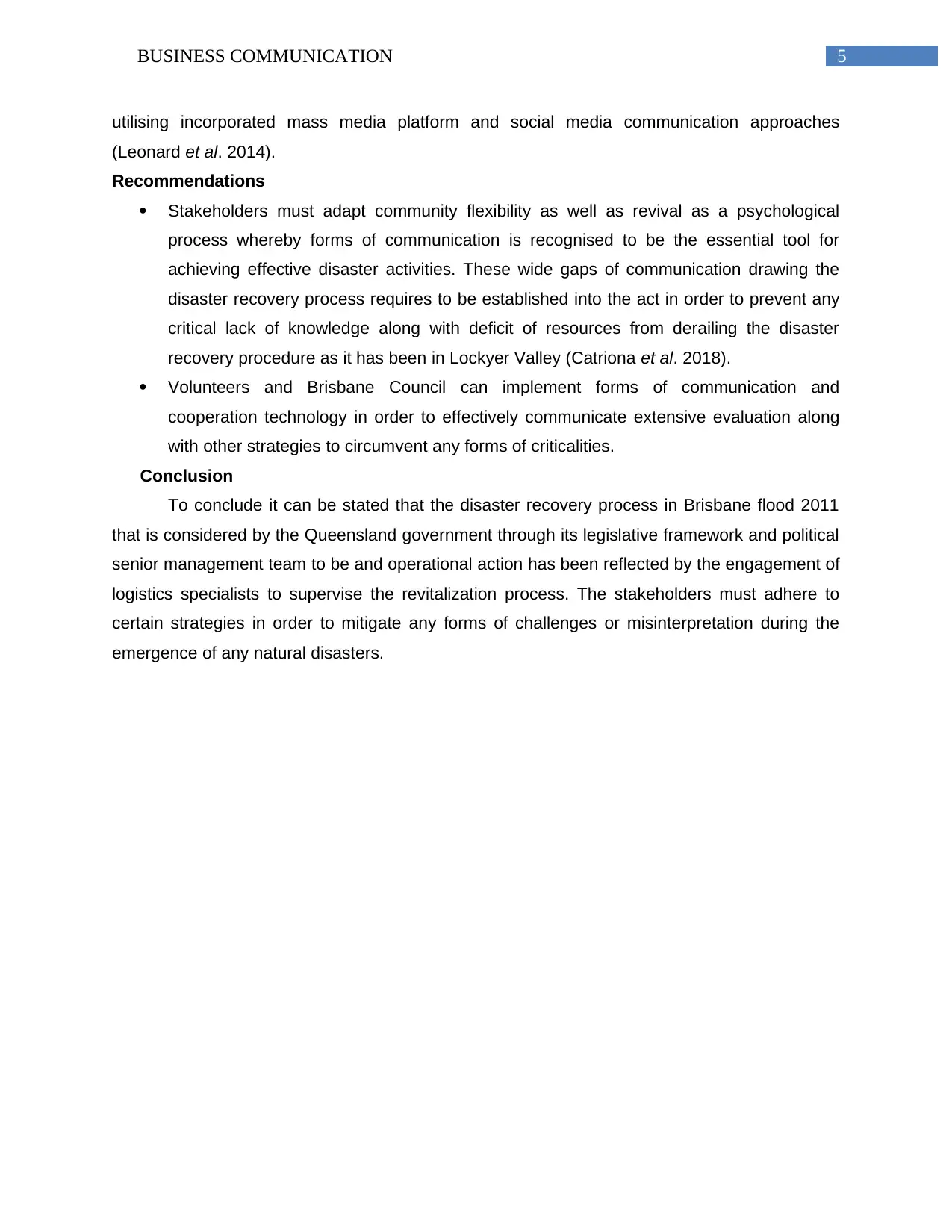
5BUSINESS COMMUNICATION
utilising incorporated mass media platform and social media communication approaches
(Leonard et al. 2014).
Recommendations
Stakeholders must adapt community flexibility as well as revival as a psychological
process whereby forms of communication is recognised to be the essential tool for
achieving effective disaster activities. These wide gaps of communication drawing the
disaster recovery process requires to be established into the act in order to prevent any
critical lack of knowledge along with deficit of resources from derailing the disaster
recovery procedure as it has been in Lockyer Valley (Catriona et al. 2018).
Volunteers and Brisbane Council can implement forms of communication and
cooperation technology in order to effectively communicate extensive evaluation along
with other strategies to circumvent any forms of criticalities.
Conclusion
To conclude it can be stated that the disaster recovery process in Brisbane flood 2011
that is considered by the Queensland government through its legislative framework and political
senior management team to be and operational action has been reflected by the engagement of
logistics specialists to supervise the revitalization process. The stakeholders must adhere to
certain strategies in order to mitigate any forms of challenges or misinterpretation during the
emergence of any natural disasters.
utilising incorporated mass media platform and social media communication approaches
(Leonard et al. 2014).
Recommendations
Stakeholders must adapt community flexibility as well as revival as a psychological
process whereby forms of communication is recognised to be the essential tool for
achieving effective disaster activities. These wide gaps of communication drawing the
disaster recovery process requires to be established into the act in order to prevent any
critical lack of knowledge along with deficit of resources from derailing the disaster
recovery procedure as it has been in Lockyer Valley (Catriona et al. 2018).
Volunteers and Brisbane Council can implement forms of communication and
cooperation technology in order to effectively communicate extensive evaluation along
with other strategies to circumvent any forms of criticalities.
Conclusion
To conclude it can be stated that the disaster recovery process in Brisbane flood 2011
that is considered by the Queensland government through its legislative framework and political
senior management team to be and operational action has been reflected by the engagement of
logistics specialists to supervise the revitalization process. The stakeholders must adhere to
certain strategies in order to mitigate any forms of challenges or misinterpretation during the
emergence of any natural disasters.
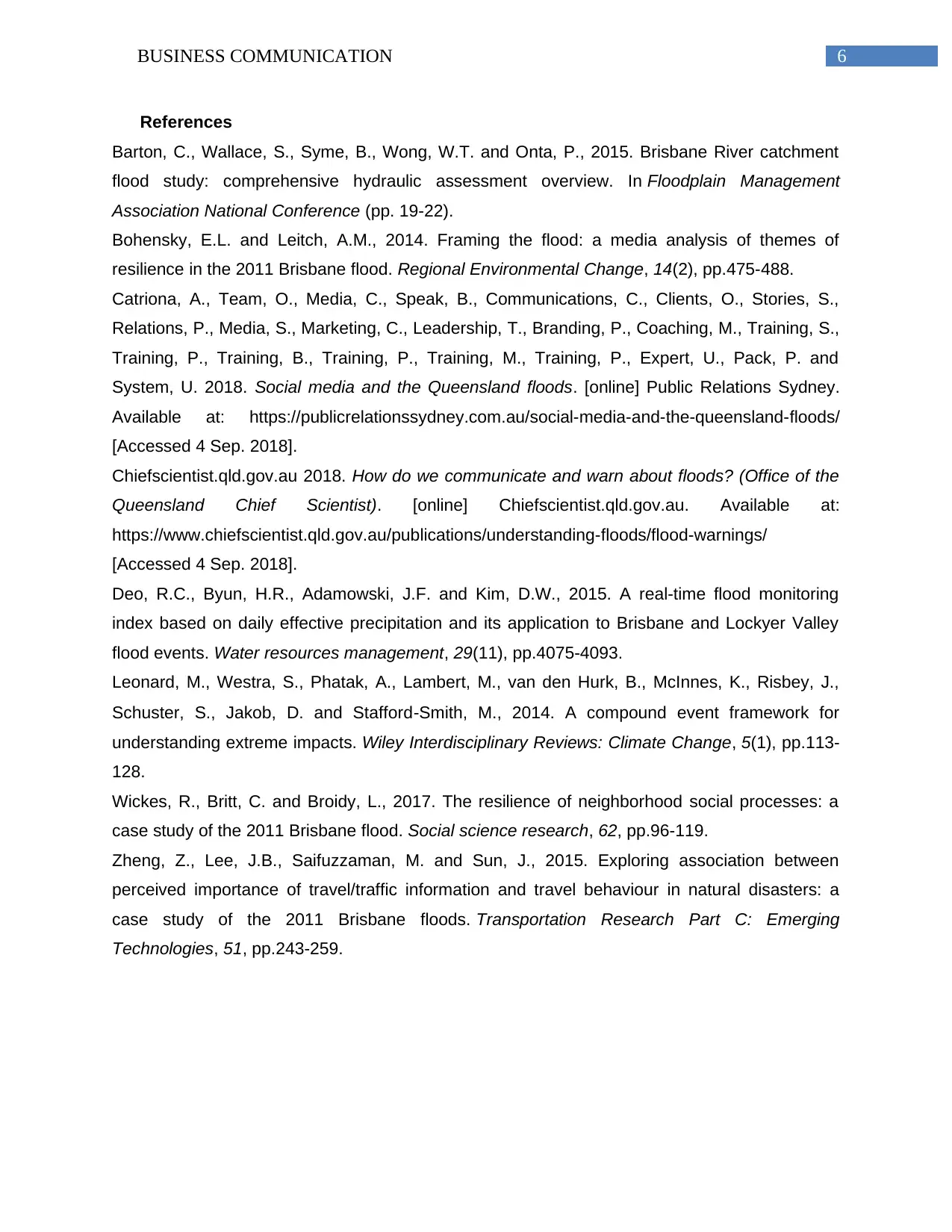
6BUSINESS COMMUNICATION
References
Barton, C., Wallace, S., Syme, B., Wong, W.T. and Onta, P., 2015. Brisbane River catchment
flood study: comprehensive hydraulic assessment overview. In Floodplain Management
Association National Conference (pp. 19-22).
Bohensky, E.L. and Leitch, A.M., 2014. Framing the flood: a media analysis of themes of
resilience in the 2011 Brisbane flood. Regional Environmental Change, 14(2), pp.475-488.
Catriona, A., Team, O., Media, C., Speak, B., Communications, C., Clients, O., Stories, S.,
Relations, P., Media, S., Marketing, C., Leadership, T., Branding, P., Coaching, M., Training, S.,
Training, P., Training, B., Training, P., Training, M., Training, P., Expert, U., Pack, P. and
System, U. 2018. Social media and the Queensland floods. [online] Public Relations Sydney.
Available at: https://publicrelationssydney.com.au/social-media-and-the-queensland-floods/
[Accessed 4 Sep. 2018].
Chiefscientist.qld.gov.au 2018. How do we communicate and warn about floods? (Office of the
Queensland Chief Scientist). [online] Chiefscientist.qld.gov.au. Available at:
https://www.chiefscientist.qld.gov.au/publications/understanding-floods/flood-warnings/
[Accessed 4 Sep. 2018].
Deo, R.C., Byun, H.R., Adamowski, J.F. and Kim, D.W., 2015. A real-time flood monitoring
index based on daily effective precipitation and its application to Brisbane and Lockyer Valley
flood events. Water resources management, 29(11), pp.4075-4093.
Leonard, M., Westra, S., Phatak, A., Lambert, M., van den Hurk, B., McInnes, K., Risbey, J.,
Schuster, S., Jakob, D. and Stafford‐Smith, M., 2014. A compound event framework for
understanding extreme impacts. Wiley Interdisciplinary Reviews: Climate Change, 5(1), pp.113-
128.
Wickes, R., Britt, C. and Broidy, L., 2017. The resilience of neighborhood social processes: a
case study of the 2011 Brisbane flood. Social science research, 62, pp.96-119.
Zheng, Z., Lee, J.B., Saifuzzaman, M. and Sun, J., 2015. Exploring association between
perceived importance of travel/traffic information and travel behaviour in natural disasters: a
case study of the 2011 Brisbane floods. Transportation Research Part C: Emerging
Technologies, 51, pp.243-259.
References
Barton, C., Wallace, S., Syme, B., Wong, W.T. and Onta, P., 2015. Brisbane River catchment
flood study: comprehensive hydraulic assessment overview. In Floodplain Management
Association National Conference (pp. 19-22).
Bohensky, E.L. and Leitch, A.M., 2014. Framing the flood: a media analysis of themes of
resilience in the 2011 Brisbane flood. Regional Environmental Change, 14(2), pp.475-488.
Catriona, A., Team, O., Media, C., Speak, B., Communications, C., Clients, O., Stories, S.,
Relations, P., Media, S., Marketing, C., Leadership, T., Branding, P., Coaching, M., Training, S.,
Training, P., Training, B., Training, P., Training, M., Training, P., Expert, U., Pack, P. and
System, U. 2018. Social media and the Queensland floods. [online] Public Relations Sydney.
Available at: https://publicrelationssydney.com.au/social-media-and-the-queensland-floods/
[Accessed 4 Sep. 2018].
Chiefscientist.qld.gov.au 2018. How do we communicate and warn about floods? (Office of the
Queensland Chief Scientist). [online] Chiefscientist.qld.gov.au. Available at:
https://www.chiefscientist.qld.gov.au/publications/understanding-floods/flood-warnings/
[Accessed 4 Sep. 2018].
Deo, R.C., Byun, H.R., Adamowski, J.F. and Kim, D.W., 2015. A real-time flood monitoring
index based on daily effective precipitation and its application to Brisbane and Lockyer Valley
flood events. Water resources management, 29(11), pp.4075-4093.
Leonard, M., Westra, S., Phatak, A., Lambert, M., van den Hurk, B., McInnes, K., Risbey, J.,
Schuster, S., Jakob, D. and Stafford‐Smith, M., 2014. A compound event framework for
understanding extreme impacts. Wiley Interdisciplinary Reviews: Climate Change, 5(1), pp.113-
128.
Wickes, R., Britt, C. and Broidy, L., 2017. The resilience of neighborhood social processes: a
case study of the 2011 Brisbane flood. Social science research, 62, pp.96-119.
Zheng, Z., Lee, J.B., Saifuzzaman, M. and Sun, J., 2015. Exploring association between
perceived importance of travel/traffic information and travel behaviour in natural disasters: a
case study of the 2011 Brisbane floods. Transportation Research Part C: Emerging
Technologies, 51, pp.243-259.
1 out of 7
Related Documents
Your All-in-One AI-Powered Toolkit for Academic Success.
+13062052269
info@desklib.com
Available 24*7 on WhatsApp / Email
![[object Object]](/_next/static/media/star-bottom.7253800d.svg)
Unlock your academic potential
© 2024 | Zucol Services PVT LTD | All rights reserved.




